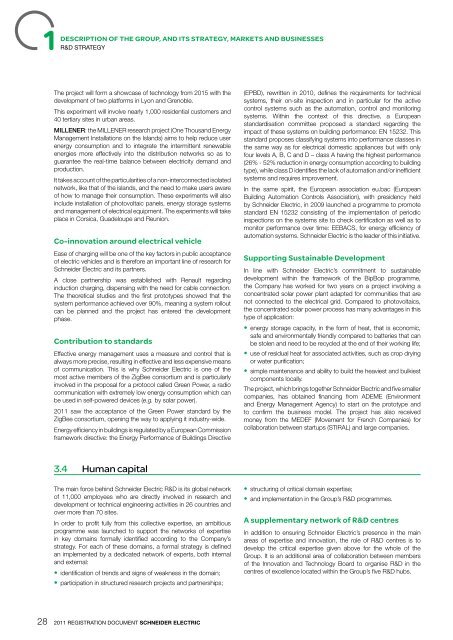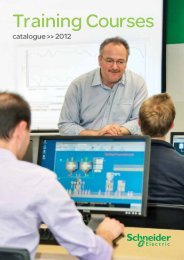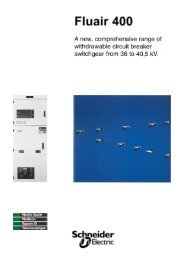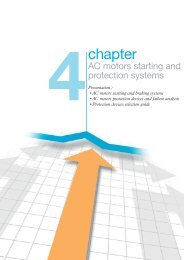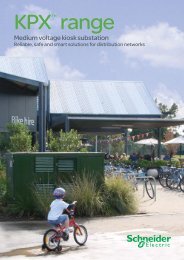Connect - Schneider Electric
Connect - Schneider Electric
Connect - Schneider Electric
Create successful ePaper yourself
Turn your PDF publications into a flip-book with our unique Google optimized e-Paper software.
1 DESCRIPTION OF THE GROUP, AND ITS STRATEGY, MARKETS AND BUSINESSES<br />
R&D STRATEGY<br />
The project will form a showcase of technology from 2015 with the<br />
development of two platforms in Lyon and Grenoble.<br />
This experiment will involve nearly 1,000 residential customers and<br />
40 tertiary sites in urban areas.<br />
MILLENER: the MILLENER research project (One Thousand Energy<br />
Management Installations on the Islands) aims to help reduce user<br />
energy consumption and to integrate the intermittent renewable<br />
energies more effectively into the distribution networks so as to<br />
guarantee the real-time balance between electricity demand and<br />
production.<br />
It takes account of the particularities of a non-interconnected isolated<br />
network, like that of the islands, and the need to make users aware<br />
of how to manage their consumption. These experiments will also<br />
include installation of photovoltaic panels, energy storage systems<br />
and management of electrical equipment. The experiments will take<br />
place in Corsica, Guadeloupe and Reunion.<br />
Co-innovation around electrical vehicle<br />
Ease of charging will be one of the key factors in public acceptance<br />
of electric vehicles and is therefore an important line of research for<br />
<strong>Schneider</strong> <strong>Electric</strong> and its partners.<br />
A close partnership was established with Renault regarding<br />
induction charging, dispensing with the need for cable connection.<br />
The theoretical studies and the fi rst prototypes showed that the<br />
system performance achieved over 90%, meaning a system rollout<br />
can be planned and the project has entered the development<br />
phase.<br />
Contribution to standards<br />
Effective energy management uses a measure and control that is<br />
always more precise, resulting in effective and less expensive means<br />
of communication. This is why <strong>Schneider</strong> <strong>Electric</strong> is one of the<br />
most active members of the ZigBee consortium and is particularly<br />
involved in the proposal for a protocol called Green Power, a radio<br />
communication with extremely low energy consumption which can<br />
be used in self-powered devices (e.g. by solar power).<br />
2011 saw the acceptance of the Green Power standard by the<br />
ZigBee consortium, opening the way to applying it industry-wide.<br />
Energy effi ciency in buildings is regulated by a European Commission<br />
framework directive: the Energy Performance of Buildings Directive<br />
3.4 Human capital<br />
The main force behind <strong>Schneider</strong> <strong>Electric</strong> R&D is its global network<br />
of 11 ,000 employees who are directly involved in research and<br />
development or technical engineering activities in 26 countries and<br />
over more than 70 sites.<br />
In order to profi t fully from this collective expertise, an ambitious<br />
programme was launched to support the networks of expertise<br />
in key domains formally identifi ed according to the Company’s<br />
strategy. For each of these domains, a formal strategy is defi ned<br />
an implemented by a dedicated network of experts, both internal<br />
and external:<br />
• identifi cation of trends and signs of weakness in the domain;<br />
• participation in structured research projects and partnerships;<br />
28 2011 REGISTRATION DOCUMENT SCHNEIDER ELECTRIC<br />
(EPBD), rewritten in 2010, defi nes the requirements for technical<br />
systems, their on-site inspection and in particular for the active<br />
control systems such as the automation, control and monitoring<br />
systems. Within the context of this directive, a European<br />
standardisation committee proposed a standard regarding the<br />
impact of these systems on building performance: EN 15232. This<br />
standard proposes classifying systems into performance classes in<br />
the same way as for electrical domestic appliances but with only<br />
four levels A, B, C and D – class A having the highest performance<br />
(26% - 52% reduction in energy consumption according to building<br />
type), while class D identifi es the lack of automation and/or ineffi cient<br />
systems and requires improvement.<br />
In the same spirit, the European association eu.bac (European<br />
Building Automation Controls Association), with presidency held<br />
by <strong>Schneider</strong> <strong>Electric</strong>, in 2009 launched a programme to promote<br />
standard EN 15232 consisting of the implementation of periodic<br />
inspections on the systems site to check certifi cation as well as to<br />
monitor performance over time: EEBACS, for energy effi ciency of<br />
automation systems. <strong>Schneider</strong> <strong>Electric</strong> is the leader of this initiative.<br />
Supporting Sustainable Development<br />
In line with <strong>Schneider</strong> <strong>Electric</strong>’s commitment to sustainable<br />
development within the framework of the BipBop programme,<br />
the Company has worked for two years on a project involving a<br />
concentrated solar power plant adapted for communities that are<br />
not connected to the electrical grid. Compared to photovoltaics,<br />
the concentrated solar power process has many advantages in this<br />
type of application:<br />
• energy storage capacity, in the form of heat, that is economic,<br />
safe and environmentally friendly compared to batteries that can<br />
be stolen and need to be recycled at the end of their working life;<br />
• use of residual heat for associated activities, such as crop drying<br />
or water purifi cation;<br />
• simple maintenance and ability to build the heaviest and bulkiest<br />
components locally.<br />
The project, which brings together <strong>Schneider</strong> <strong>Electric</strong> and fi ve smaller<br />
companies, has obtained fi nancing from ADEME (Environment<br />
and Energy Management Agency) to start on the prototype and<br />
to confi rm the business model. The project has also received<br />
money from the MEDEF (Movement for French Companies) for<br />
collaboration between startups (STIRAL) and large companies.<br />
• structuring of critical domain expertise;<br />
• and implementation in the Group’s R&D programmes.<br />
A supplementary network of R&D centres<br />
In addition to ensuring <strong>Schneider</strong> <strong>Electric</strong>’s presence in the main<br />
areas of expertise and innovation, the role of R&D centres is to<br />
develop the critical expertise given above for the whole of the<br />
Group. It is an additional area of collaboration between members<br />
of the Innovation and Technology Board to organise R&D in the<br />
centres of excellence located within the Group’s fi ve R&D hubs.


